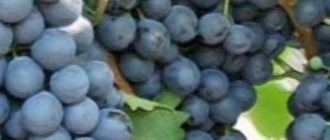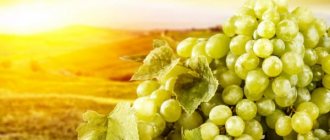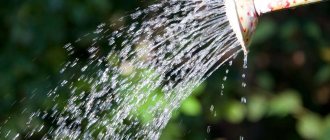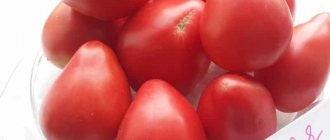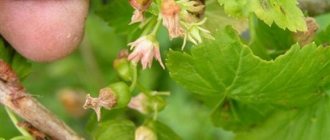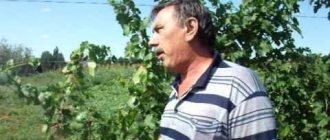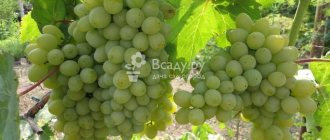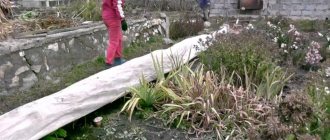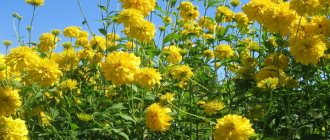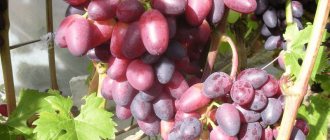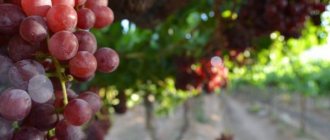The vine is a child of the Earth and the Sun. Its berries are filled with life-giving power that is available to humans. According to legend, yellow grapes absorb the energy of daylight, red grapes symbolize the morning dawn, dark blue and black berries hide the secret of the southern night. You can reveal this very secret by trying the fruits of the magnificent Baikonur variety. It is one of the most promising new products on the market and has already won many fans and admirers. Its popularity and demand is explained by its excellent product, taste and agrotechnical qualities. All the most relevant and useful information about this unique variety can be found further in this article.
Main characteristics
“Baikonur” is an early grape variety that has high yields and a harmonious taste with fruity notes.
Ripening period
The variety can safely be considered early ripening, since the duration of its growing season is 110-115 days.
Bush
The bush of the variety is always powerful and strong. The leaves are bright green in color. The flowers are bisexual, from which large juicy berries are formed after 3.5 months.
Bunches and berries
The conical bunch reaches a length of 20–30 cm and weighs 0.7–1.5 kilograms. The density of berries in the bunch is average.
Pink-red, and when exposed to the sun, dark purple, elongated, finger-shaped berries usually weigh 12-16 grams. The skin is soft, of medium thickness, covers the juicy jelly pulp and is well fused with it. It is easily chewed in the mouth along with the seeds and pulp. The fruits are covered with dense pruin. The fruits are sweet with a slight sourness, very juicy, with a sugar content of about 20% and an acid content of about 7%.
Taste and yield
The taste is pleasant, harmonious, with light fruity notes. Productivity is high. From one bush you can collect from 20 to 30 kg of ripe, large grape bunches.
How the Baikonur grape variety blooms and bears fruit
Baikonur grapes: photo of variety
The Baikonur grape variety always blooms quite actively; the flowers of this grape have both sexes, so pollination occurs without any difficulties. Fruiting occurs, as a rule, one hundred five to one hundred and fifteen days after the growing season has begun.
If weather conditions are favorable, the harvest can be harvested in the last days of July. However, grape clusters ripen until the last days of October. The first ripe bunches do not weigh too much. One brush can weigh about five hundred grams.
Those clusters that ripen later are much larger and can weigh from seven hundred to nine hundred grams. How abundant the harvest will be depends greatly on the growing conditions.
An important factor in caring for the Baikonur grape variety is proper watering of the grape plants. If you see that the clusters are very large and full, then be sure to install additional support. This measure will help facilitate the plant’s process of forming new clusters.
Comparison with analogues
The “Baikonur” variety looks good in comparison with other early varieties of black grapes: the weight of its clusters, the indicators of sugar accumulation are striking, and the unusual taste pleases.
| Sign | Variety | |||
| Baikonur | Gala | Jupiter | Codrianca | |
| Ripening period | 110 – 115 days | 110 -115 days | 110 – 120 days | 110 – 120 days |
| Frost resistance | -23ºС | -22ºС | -29ºС | -24ºС |
| Productivity | 20 – 30 kg | Up to 23 kg | 20 – 30 kg | Up to 50 kg |
| Bunches | 0.7 – up to 3 kg | 0.5 – 1.5 kg | 300 – 500g | 400 g – 1.5 kg |
| Taste | Fruity notes | Sweet and sour, simple | Notes of strawberry and nutmeg | Harmonious |
| Color | Dark purple | Dark blue | Dark purple | Dark purple |
| Disease resistance | Average | Above average | Above average | Above average |
| Shelf life | 3 months | 3 months | 3 months | 3 months |
| Sugar accumulation | 19 – 20% | 16,50% | 21% | 18 – 19% |
| Acidity | 6 – 7 g/l | 6 – 8 g/l | 5 – 6 g/l | 6 – 7 chapters |
What type does it belong to?
This is a table variety with early ripening berries . The advantage of the table variety is that it retains its presentation .
The berries, as a rule, grow much larger than technical varieties. They are meatier, more aromatic, and are well suited for eating and making homemade compotes, jam, baked goods, etc.
Technical varieties include Bianka, Levokumsky, Crystal.
Useful properties and applications
Polyphenols are organic compounds that perform a protective function against the negative effects of an aggressive environment and a host of other beneficial properties:
- Antioxidant: polyphenols activate rejuvenating processes in the body, slowing down aging.
- Cardioprotective: grapes and their polyphenols, resveratrol, in particular, help strengthen the heart muscle, capillary walls of blood vessels, improve blood composition and restore full blood circulation.
- Protects against degenerative processes of the nervous system: resveratrol and proanthocyanidins activate cognitive abilities, improve memory and attention, preventing Alzheimer's disease.
- Antitumor: anthocyanins, resveratrol, proanthocyanidins and some phenolic acids inhibit the growth of tumors, especially those developing on the skin and in the gastrointestinal tract.
- Anti-inflammatory and antibacterial: polyphenols help strengthen the immune system, reduce the risk of contracting infectious diseases, and have an antipyretic effect.
100 g of black berries of Baikonur grapes contain about 72 kcal.
Reference! Black varieties have 7 to 10 times more polyphenolic compounds than other grape varieties. 30% of their total amount is contained in the peel and about 60% in the seeds.
The Baikonur variety is considered universal because its scope of application is extremely wide:
- For fresh consumption.
- Making jam, jam.
- As an ingredient in vegetable salads, fruit slices, desserts.
- As a raw material for producing juice and wine.
- In cosmetology: it is part of masks and scrubs for the face and body.
- In folk medicine as a component of various tinctures and lotions.
History of selection
Baikonur grapes are considered a newcomer among the numerous varieties of crops. Despite the fact that the variety appeared relatively recently, it has already gained success and is in demand among domestic gardeners. It was bred by non-professional breeder E. G. Pavlovsky as a result of crossing two varieties of grapes.
Find out whether grapes can cause allergies and how they manifest themselves.
The genetic basis of the crop is considered to be the Talisman and Krasotka varieties, among which the first is distinguished by its high resistance to diseases, and the second by the attractive appearance of the berries and their excellent taste.
Thanks to painstaking breeding work, Pavlovsky managed to obtain a new hybrid that combined all the positive qualities of its parent forms - resistance to the external environment, frost resistance, transportability and excellent commercial qualities.
Due to its high physical characteristics, Baikonur quickly became widespread in regions with different climatic conditions. One of its advantages is the ability to grow grapes in areas with an unfavorable climate. The most widespread distribution of the hybrid was noted in 2012. However, given the relative youth of the variety, the features of its agricultural technology have not been fully studied and complete descriptions of the intricacies of growing the hybrid do not exist.
Did you know? Some grape varieties can grow for 100 or even more years. The surprising thing is that the more time passes, the better harvests such a bush brings.
Features of cultivation
The relatively new variety “Baikonur” has already managed to captivate many gardeners and grape consumers with its characteristics.
Planting time and soil
The best time to plant Baikonur grape seedlings in the ground is spring (from March to May) and autumn (before the first frost). The winegrower must decide on the exact date, based on the climatic characteristics of the region. In southern latitudes, planting work is usually carried out in the fall, and in areas with a temperate or cold climate - in the spring.
Reference! The root system of a seedling develops very quickly, so the planting hole for growing it must initially be solid - at least 60 cm deep on light soils and 80 cm on clay soils. Recommended diameter: 80 cm.
“Baikonur”, like any other grape variety, prefers a well-lit area, hidden from wind and drafts. It is better if it is located a little higher: this way the risk of excess moisture stagnating at the roots will be reduced to zero. The preferred soil type is light, fertile, loose soil with medium or low salt levels. If the soil on the site leaves much to be desired, then it is permissible to enrich it with manure and river sand to make it loose.
Watering and fertilizing
The variety does not like excess moisture; it needs to be watered only 3–4 times per season, but generously (60–80 liters per adult plant). Young plants, of course, more often - 2 - 3 times a month.
Particular attention should be paid to irrigation during the flowering period, the formation of ovaries and the ripening phase of fruits. Autumn watering is also required, during which 70 liters of water must be poured under each adult bush. Watering must be stopped completely 2 - 3 weeks before harvest.
which is carried out according to a strictly defined scheme , plays an equally important role for the normal development of grapes
- The first is after planting the plant in the ground or after removing the insulation (add humus or superphosphate).
- The second and third - before and after flowering (ash, solutions of complex fertilizers at the root).
- The third - during the period of fruit ripening (mineral fertilizers based on potassium and phosphorus).
Trimming
Formative pruning can be carried out both in spring and autumn. The main thing is that it is carried out, otherwise a good harvest can be forgotten. The optimal load on the bush has not yet been established, but usually winegrowers shorten the shoots by an average of 10 buds. Young one-year-old plants have 2–4 eyes.
Diseases and pests
Since the variety and its characteristics have not yet been fully studied, it is too early to draw final conclusions about its resistance to diseases.
Grape growers and farmers cultivating “Baikonur” consider preventive treatments with fungicides (after grape flowering and after natural precipitation) to be an integral stage of plant care, which are designed to prevent infection of grape bushes with fungal diseases. Well, standard measures: irrigating the plant with a 3-5% solution of iron sulfate before covering the vineyard, as well as spraying with Bordeaux mixture (3%) on the eve of flowering.
An undoubted advantage of the variety: it is practically not affected by wasps and bees. However, its berries may attract birds.
Whatever measures to combat them are taken, experienced gardeners recommend not to be lazy and put a special fine-mesh bag on each bunch, which will protect the berries from both birds and insects
Frost resistance
The variety is frost-resistant: it can withstand temperatures down to -23ºС. To avoid the unpleasant consequences of exposure to sub-zero temperatures, especially in regions with cold and little snowy winters or significant temperature changes, it is better to insulate the plant.
2 weeks after pruning and processing the grapes, the vines should be removed from the trellises, collected in a bunch and bent to the ground. They can be secured with special staples or hooks, and then covered with light, breathable material.
Many winegrowers practice covering the vines with soil.
Attention! Measures to insulate grapes for the winter should be carried out in dry weather at a temperature of +5ºС – +10ºС.
Harvest storage
The variety has the ability to retain its taste characteristics and excellent presentation for a long time. In the refrigerator, or even better in the cellar, the fruits are perfectly preserved for 3 months.
Cultivation regions
One of the advantages of “Baikonur” is the possibility of growing it in regions with an unfavorable climate for southern heat-loving crops: the western regions, the middle zone and the Moscow region.
Diseases
Baikonur is a fairly protected variety. It rarely suffers from diseases and is quite resistant to attacks by various pests. But, nevertheless, this does not mean that it is enough to plant a bush and forget about it until harvest. Preventative measures should always be taken.
Basic measures for caring for grapes:
- Autumn pruning of leaves and shoots.
- Digging and mulching the soil around the plant shoot.
- Tying long vines. This will keep them from self-harming.
- During flowering, treat the bush with special preparations to protect against oidium and mildew.
Reviews
The form was vigorous, there were no signs of disease. The berry is very large, up to 4.5 cm. It easily reaches, has a nipple-shaped berry, a very beautiful dark color. The bunch is semi-loose and looks elegant. The pulp is dense, juicy, harmonious taste, but rather complex. This grape deserves our attention and has good prospects. Irina Ivanovna, Krasnodar region
The taste is harmonious, rich, rich, the aftertaste is pleasant, refreshing, sugar 19-20. The pulp is fleshy and juicy, the berry stays very tightly on the ridge. The skin is torn; attention is not paid when eating. Sergey, Kursk region, Ponyri village
The yield is high, there are no signs of fungal diseases. After a very heavy rainfall, no cracking was observed. Decent form, in my opinion. Oleg Ivanovich, Stavropol Territory
